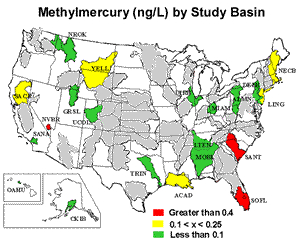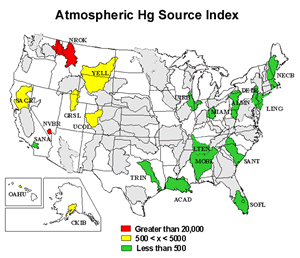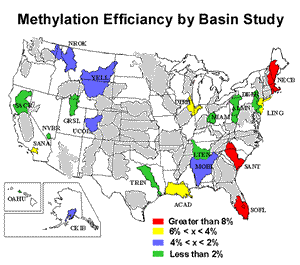National Assessment Study of Mercury Contamination of Aquatic Ecosystems
Project Number: xxx
Project Chief: Dave Krabbenhoft
Project Topics: mercury, biogeochemical processes, bioaccumulation
Cooperators: USGS Toxic Substances Hydrology Program; NAWQA
Period of Project: yyyy to present
 Introduction Introduction
This project brings together the expertise of an interdisciplinary team of scientists and programs to execute an integrated monitoring and research plan that will take a holistic approach toward examining mercury cycling and bioaccumulation at a set of NAWQA watersheds across the United States, which exhibit widely ranging ecosystem conditions, mercury sources, and biological components (food webs).
The project employs the combined talents, interests, and funding of scientists from the NAWQA, Toxics, and NRP programs of the Water Resources Discipline, as well as scientists and programs from the Biological Resources Discipline of the USGS.
In essence, this proposal distills the "mercury problem" down to three forcing functions that we believe control mercury toxicity in aquatic ecosystems:
- source characterization, apportionment and quantification;
- the biogeochemical processes that lead to the formation of methylmercury; and,
- the introduction of methylmercury into the food web (bioaccumulation) and biomagnification steps that follow.
These three forcing functions are referred to here as the Mercury Triad. Our overall research objective is to determine what environmental and biological factors govern the methylation of mercury and its resulting bioaccumulation in aquatic ecosystems.
 We have identified five NAWQA study basins (CONN, GAFL, WMIC, WILM, and NVBR) that present a unique opportunity to extend the three pieces of the Mercury Triad in such a way that we be able elucidate the relative importance of these forcing functions under varying environmental conditions. We have identified five NAWQA study basins (CONN, GAFL, WMIC, WILM, and NVBR) that present a unique opportunity to extend the three pieces of the Mercury Triad in such a way that we be able elucidate the relative importance of these forcing functions under varying environmental conditions.
A primary strength of this effort is the adoption of a consistent set of research questions and field and laboratory methods that will be applied to each of the study basins, such that the results will not only be comparable among basins but transferable to other locations in the US.
Problem
Mercury contamination of environment and toxicological exposure to wildlife and humans is a complex problem that is unlike any other contaminant issue mankind has ever been confronted with, and requires a special level of holistic, interdisciplinary research before we will be able to take effective steps toward improving environmental conditions.
 First, it is unique among all known elements in that at ambient pressure and temperature its stable phase is as a metallic liquid that is highly vaporous. Thus, unlike all other heavy metals of general concern, it is effectively distributed in the gaseous state to literally any location, including sensitive ecosystems. First, it is unique among all known elements in that at ambient pressure and temperature its stable phase is as a metallic liquid that is highly vaporous. Thus, unlike all other heavy metals of general concern, it is effectively distributed in the gaseous state to literally any location, including sensitive ecosystems.
Second, because mercury is an element, releases from both natural and anthropogenic sources are difficult to discriminate and mutually accumulate in various pools in the environment (primarily soils and sediments) where unlike most other contaminants of widespread concern it does not degrade over time and potentially presents a contamination problem for very long periods of time.
Third, unlike most contaminants where biogeochemical processes generally serve to moderate its expressed toxicity, several key natural processes actually served to exacerbate mercury toxicity by converting it to methylmercury, a highly potent neurotoxin that is the focus of most environmental mercury research today. In fact, if mercury were not methylated in the environment, there essentially would be no mercury problem, and as such the "mercury problem" is really a "methylmercury problem".
Mercury methylation is the net result of a vexing series of physical, chemical and microbiological processes, which in an unfortunate twist originate at or near the base of food webs in aquatic ecosystems and effectively serve to "inject" it into the food web from the point of orgination. Although mercury methylation is the focus of intense research currently, it is still poorly understood especially at the national scale.
 The challenge currently confronting resource managers, lawmakers, and the scientific community at large is to bring this complex problem into a more complete understanding that will allow for the proper and responsible actions to not only reduce new releases to the environment, but also prescribe effective land management strategies to deal with existing inventories. The challenge currently confronting resource managers, lawmakers, and the scientific community at large is to bring this complex problem into a more complete understanding that will allow for the proper and responsible actions to not only reduce new releases to the environment, but also prescribe effective land management strategies to deal with existing inventories.
Objectives
Objectives of this study are to:
- Evaluate if trends in mercury accumulation and methylmercury production can be identified at national and regional scales across the United States
- To identify ecosystem characteristics that favor the production and bioaccumulation of methylmercury.
- Study design looks at a national scope with emphasis on multimedia sample collection (water, sediment, and predator fish) with consistent use of trace metal clean sampling methods and low-level mercury and methylmercury analytical procedures.
|

